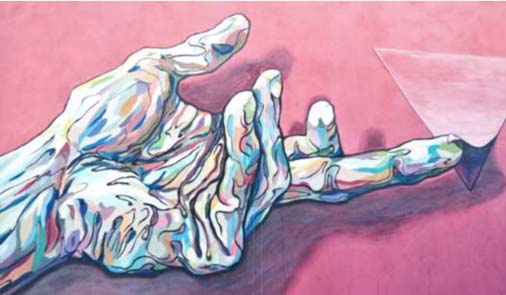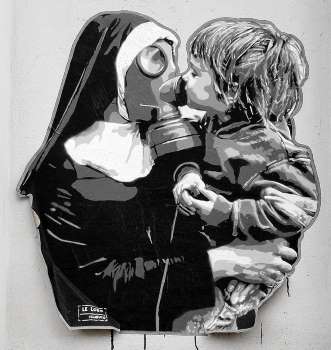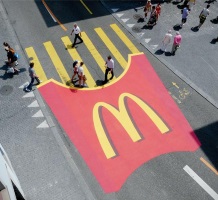
What is art
What one art lover enjoys, another will dislike intensely. That’s the nature of art. Different artists interpret the meaning of the word in different ways.
Learn moreIn the later years of the 20th century, street art rose to prominence. Today, some of the best-known artists like Banksy focus almost solely on this medium, so what exactly is street art and what is the message behind it?
Street art has a close relationship with graffiti art in the respect that both are generally unsanctioned and are created within public spaces. However, street art covers a broader spectrum of media with a stronger connection with the world of graphic design.
Modern graffiti tends to revolve around text-based content and tagging. Street art, on the other hand, is more open. Street art has no rules, although there are a few common techniques and materials which are widespread including fly posting, video projection, freehand drawing, stickers and stenciling.
Most street artists work in a studio and hold exhibitions in galleries. They aren't anti-art but instead prefer having the freedom to work in a public arena with no need to worry about the opinions of others.
 The Street
Art genre is tricky to pin down in terms of roots. If we look back centuries, we see its origins in the cave paintings of the stone age as well
as in the images and stenciled slogans seen in political campaigns through the ages.
The Street
Art genre is tricky to pin down in terms of roots. If we look back centuries, we see its origins in the cave paintings of the stone age as well
as in the images and stenciled slogans seen in political campaigns through the ages.
Today’s Street Art is sometimes called Urban Art and its primary purpose is to deliver a social commentary at the same time as illustrating the 21st-century urban-dweller's subconscious. There are traditional genres to be seen, however they are interpreted in a new way, with surrealism, portraiture and pop art all having a role to play, albeit with a brand new look. Random symbols and references run through street art's story, with psychedelic humor being a prominent theme. Any subject can be discussed through this medium, and spiky comments about the world and its current state exist. The overall attitude of street art is one of freedom, democracy and irreverence.
Above all, street art’s defining feature lies in its accessibility. The whole point is to bring art to the masses, with no need to go to a gallery or exhibition. Anyone can walk down the street and see art on a boarded-up window or online. It’s no wonder, then, that some galleries have begun to showcase this type of artwork, having finally recognized its importance.
Before modern street art and graffiti, slogans expressing social or political commentary were found written on public walls. Iconic graphics and simple text were the very earliest forms of street art although it is generally acknowledged that the true birth of street art occurred in New York City during the graffiti art boom of the 1960s. This art form matured during the decade that followed and peaked during the 1980s when subway train cars boasted fully spray-painted murals.
As the years went on, the text-based artworks of the early years of the 1980s gave way to visual concepts like the shadow figures created by Hambleton. Although street art of that time was not yet a realistic career for any artist, the popularity of these works of art led into many street art wheatpasted poster artworks being accepted as actual artworks and thus they became commonly seen in towns and cities around the world during the late 1980s. At this time, too, the Punk Rock movement also led to the evolution of street art thanks to its subversive ideology.
When it comes to legal issues, street art comes in a category of its own. The parties which are involved in this art form can include only the artist themselves, or the artist in conjunction with the municipal city or government. Alternatively, the artwork’s intended recipient or the building’s owner on which the art is displayed may also be involved. The result can be a complex blend of ethical, moral and legal questions.
 One classic
example of this occurred in 2014 in England when Banksy’s work “Mobile Lovers” was painted onto a public doorway. The plywood on which it
was painted was then cut out by a private citizen who intended to sell the work as a way of raising funds for the Boys Club. The artwork was,
in turn, confiscated by the city’s government. It was then put in a museum. When Banksy, the artist, heard about the problem, he bequeathed
it to the citizen who had intended to sell the piece, believing in the genuine nature of his intentions.
One classic
example of this occurred in 2014 in England when Banksy’s work “Mobile Lovers” was painted onto a public doorway. The plywood on which it
was painted was then cut out by a private citizen who intended to sell the work as a way of raising funds for the Boys Club. The artwork was,
in turn, confiscated by the city’s government. It was then put in a museum. When Banksy, the artist, heard about the problem, he bequeathed
it to the citizen who had intended to sell the piece, believing in the genuine nature of his intentions.
This case proves that there is a controversy between public property and ownership of art, and these only add to the additional issues of vandalism and trespassing which are linked to street art. All of these are issues which need to be resolved when it comes to dealing with street art as a genre.
Street art has been so successful in its original form that it is now one of the most lucrative mediums used for advertising by powerful companies that which to target their products at the young and edgy within specific subcultures.
By buying into this art style, advertisers are able to improve the profitability of their market activity. We only need to look at advertising for events and festivals which is targeted at particular groups of young people. Companies are able to become a founder and organizer of a specific event while also advertising a particular product. Although this may sound like a purely commercial enterprise, in fact these campaigns and events could represent an ideal way for emerging street artists to become noticed within the arena of the art world as a whole.

When looking at advertising in the world of street art, there are two key stances to look at. One involves the communication methods and language of the piece while the other concerns its location in the public sphere in whatever form it takes.
By creating meaning through the use of symbolic messages, the subjects of the art and the advertisement can assume a different role.
Street art may look like artistic vandalism, however in fact it can be harnessed as a form of guerrilla-style marketing campaign. This is something which has been used to great potential by big name brands like Sony who used a similar campaign style to launch their PlayStation Portable a decade ago. In some of the world's biggest cities, Sony even paid owners of buildings for the rights to use their wall space so they could launch their campaign. This was one of the biggest and best-known efforts of any major corporation to capitalize on street art's popularity in order to reach the urban market which has already learned how to tune out the noise of standard advertising tactics. Back in 2003, Nokia used the medium of sidewalk chalk pictures to promote their latest cell phone of the day.
The reason that street art is so popular with advertisers is the drive to reach consumers who want to enjoy entertainment while on the move.
The move towards companies harnessing the power of street art to promote their products has led to many street artists now turning to corporate advertising work so they can make ends meet. Yet they insist they are still working in the same creative way, just with a different medium. Many hope that with their commercial work they will be able to help clients to engage with audiences that they previously struggled to communicate with.
On the other hand, there are also plenty of street artists doing corporate work who are highly critical of companies which try to use stealthy street art style advertising campaigns. Companies which try to disguise their sponsorship on street art marketing artworks risk damaging their reputation according to many street artists.
For companies, street art often represents an especially tempting way of getting noticed in an overcrowded public arena. Even Time magazine has got in on the act, having previously paid graffiti artists to decorate walls in New York in an attempt to cut through the mess of marketing messages which New Yorkers were subjected to on a daily basis.
Street artists grasp the strategy, although not all are on board with it. Some decry the lack of any originality in street art-style campaigns however, at the end of the day, they mostly acknowledge that the decision really lies in the hands of the public. It is up to the beholder to judge the value of art, and therefore, the only way of determining what type of art is good is really to listen to public opinion.
Whether you love street art or hate it, the fact remains that it is still as valid art form as any other art forms out there. In fact, perhaps even more so than at any other time in its history. The main question is, if street art goes completely mainstream, can it maintain its edgy vibe and the motivation that makes it what it is?

What one art lover enjoys, another will dislike intensely. That’s the nature of art. Different artists interpret the meaning of the word in different ways.
Learn more
Many of the materials used to make handcrafted pieces exceed the boundary of the West's tradition of fine art. Materials like wood, metal, textiles, glass and ceramics are often used.
Learn more